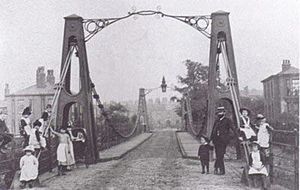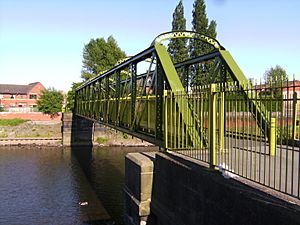Broughton Suspension Bridge facts for kids
The Broughton Suspension Bridge was an iron chain suspension bridge. It was built in 1826. The bridge crossed the River Irwell in Salford, England. It connected the areas of Broughton and Pendleton.
This bridge was one of the first suspension bridges in Europe. Some people believe Samuel Brown designed it. Others think Thomas Cheek Hewes, a local millwright, built it.
On April 12, 1831, the bridge suddenly collapsed. This happened when soldiers were marching across it. Their marching steps caused the bridge to vibrate strongly. Because of this event, the British Army made a new rule. Soldiers must now "break step" when crossing any bridge.
The bridge was later rebuilt and made stronger. However, it was still supported with extra wooden poles when many people were expected. In 1924, a new Pratt truss footbridge replaced it. This newer bridge is still used today.
Contents
Building the Broughton Bridge
In 1826, a rich man named John Fitzgerald paid for the bridge himself. He owned a large house nearby called Castle Irwell House. The bridge was 144 feet (44 m) long. It stretched across the River Irwell.
The bridge connected Lower Broughton and Pendleton. People had to pay a small fee, called a pontage, to cross it. This bridge was the only way to travel between these two areas.
People in the area were very proud of the bridge. Suspension bridges were a new and exciting invention back then. The famous Menai Suspension Bridge had just opened that same year.
Why the Bridge Collapsed
On April 12, 1831, a group of soldiers was returning from an exercise. They were from the King's Royal Rifle Corps. About 74 men were marching four abreast (four in a row). As they walked onto the bridge, they felt it shake.
The soldiers thought this was funny. Some started whistling a marching tune. They even changed their steps to make the bridge shake more. As the first soldiers reached the other side, they heard a loud noise. It sounded like many gunshots.
Suddenly, one of the iron columns holding the bridge chains fell. It pulled a large stone from the bridge support with it. The corner of the bridge then dropped about 16 or 18 feet (4.9 or 5.5 m) into the river. Around 40 soldiers fell into the water or hit the chains.
Luckily, the river was shallow, only about two feet deep. No one died in the accident. However, 20 soldiers were hurt. Six of them had serious injuries, including broken bones and bad bruises.
What Caused the Collapse
An investigation looked into why the bridge fell. They found that a bolt in one of the support chains had broken. This bolt connected the chain to the ground. The report said the way it was built was not good. It used only one bolt instead of two. Also, the bolt itself was poorly made.
Years before the accident, an engineer named Eaton Hodgkinson had worried about the chains. He thought they might not be strong enough. He suggested testing them carefully, but this was not done.
The investigation concluded that the strong vibrations from the marching caused the bolt to break. However, they also believed the bolt would have failed eventually anyway.
What Happened Next

The collapse of the Broughton Bridge made some people lose trust in suspension bridges. A newspaper at the time wondered if even the huge Menai Suspension Bridge would be safe if many soldiers marched across it.
But this event did not stop new suspension bridges from being built. The most important result was a new rule for the British Army. Soldiers were ordered to "break step" when crossing bridges. This means they should not march in perfect rhythm. French soldiers also got this order.
Even so, marching was blamed for another bridge collapse in France in 1850. That accident, involving the Angers Bridge, killed over 200 soldiers during a storm.
The Broughton Suspension Bridge was rebuilt and made much stronger. But it was still supported with temporary wooden poles when large crowds were expected. The old suspension bridge was finally replaced in 1924. A new Pratt truss footbridge was built. It cost about £2,300 and is still in use today.
Images for kids





